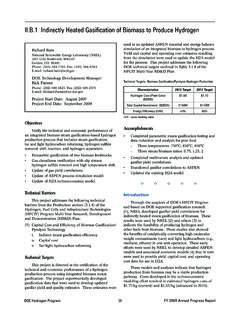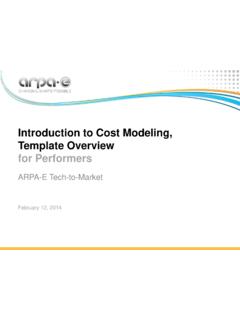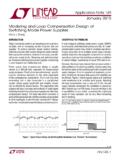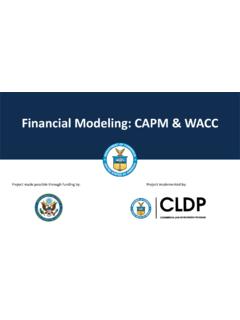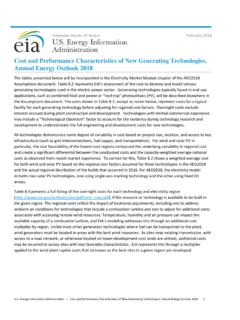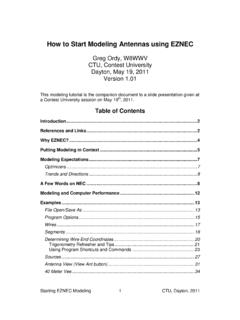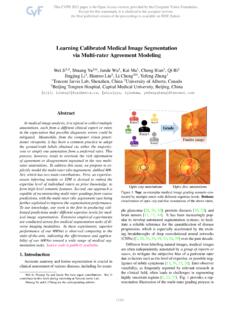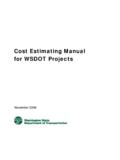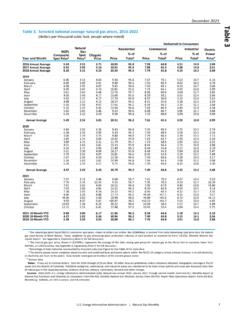Transcription of Hydrogen Storage Cost Analysis, Preliminary Results
1 Hydrogen Storage cost analysis , Preliminary Results Brian D. James Strategic analysis , Inc. 15 May 2012. Project ID ST100. This presentation does not contain any proprietary, confidential, or otherwise restricted information Overview Timeline Barriers Project start date: 9/30/11 System cost : Project end date: Realistic, process-based system costs 11/30/12, Budget Period 1 Need for realistic values for current and 9/29/16, all 5 Budget Periods future cost targets Percent complete: Demonstrates impact of technical targets 25% of Budget Period 1 & barriers on system cost : Balance of plant components Materials of construction Budget System size and capacity (weight and Total project funding volume). $2M for all 5 years System Life-Cycle Assessment cost Share: 0% (not req. for analysis projects). Funding Received in FY11: Partners $125k (new project). Argonne National Laboratory Funding for FY12: National Renewable Energy Laboratory $255K total $165K SA.
2 $60k ANL. $30k NREL. 2 2. Relevance: Objectives Overall goal of project: Process-based cost analysis of current & future H2 Storage technologies. To be used to gauge and guide DOE R&D efforts. Validate cost analysis methodology so there is confidence when methods are applied to novel systems Sensitivity studies Determine the cost impact of specific components on the overall system. Five-year project, annually renewed Analyze systems of interest identified by DOE. Allows researchers cost impact updates throughout year and feedback on technical advances or proposed strategies Identify most fruitful research paths to cost reduction System technology and design parameters System size and capacity Balance of plant components Materials of construction 3 3. Relevance: Systems of Interest First analysis is of pressure vessel systems These Results will be presented today Results to be vetted against proprietary industry numbers for similar systems in order to validate costing methodology Second & third cost analyses focus on off-board recycle costs Recycle process for spent fuel from Alane and Ammonia Borane on-board Storage systems Additional Storage technologies for cost analysis will be selected by DOE in the future As needed, past analyses will be updated to reflect altered performance/assumptions/design 4 4.
3 Approach: SA's DFMA - Style Costing Methodology What is DFMA? DFMA (Design for Manufacturing & Assembly) is a registered trademark of Boothroyd-Dewhurst, Inc. Used by hundreds of companies world-wide Basis of Ford Motor Co. design/costing method for the past 20+ years SA practices are a blend of: Textbook DFMA , industry standards and practices, DFMA software, innovation, and practicality Estimated cost = (Material cost + Processing cost + Assembly cost ) x Markup Factor Manufacturing cost Factors: Methodology Reflects cost of Under-utilization: 1. Material Costs Capital cost Initial Used to calculate 2. Manufacturing Method annual capital recovery Installation Expenses factor based on: 3. Machine Rate Equipment Life 4. Tooling Amortization Interest Rate Maintenance/Spare Operating Corporate Tax Rate Parts Utilities Expenses Miscellaneous Annual Annual +. Capital Operating Machine Rate Repayment Payments =.
4 ($/min). Annual Minutes of Equipment Operation 5 5. Approach: cost Factors Included in Estimates Not Included in cost analysis Markup for primary manufacturer/assembler Profit (G&A, scrap, R&D, profit) cost Non-recurring RD&E costs One-Time Excluded Warranty Advertising Costs from SA. Taxes analysis General Expenses Included in cost analysis OEM. Fixed Costs Factory Price Equipment depreciation Expenses Tooling amortization cost Utilities Maintenance Direct Included in Variable Costs Materials SA. Direct Materials used in manufacturing analysis Direct Materials purchased from Direct suppliers Labor Manufacturing scrap Manufacturing labor Assembly labor 6 6. Approach: Basic cost Modeling Work Flow 1. Obtain or create system design for technology of interest ANL/HSECoE (typically) provides key parameters, system diagram 2. Develop physical embodiment of system design Materials, scaling, dimensions, design embodiment ANL/HSECoE/other may provide design details 3.
5 Investigate & conceptually model the manufacturing process train for system production Manufacturing methods based on SA experience, industry input, analogy to similar products 4. Vary key parameters to obtain sensitivity data for modeled technology 5. Share Results with ANL, NREL, DOE, HSECoE, and Industry to obtain feedback/improvements 6. Modify cost analysis as needed HSECoE = Hydrogen Storage Engineering Center of Excellence 7 7. Accomplishments: Pressure Vessel cost analysis Estimate cost of H2 Pressure Vessels to provide validation of cost analysis methodology Baseline system (Complete): kg H2 (usable) at 700bar Carbon Fiber, Type 4 pressure vessel Single tank system design Include Balance of Plant components List all assumptions and analysis steps Conduct sensitivity analysis of key parameters Sensitivity analysis (Complete): Explore cost of systems holding 4-8 kgH2. Examine five annual system production rates: 10k, 30k, 80k, 130k, and 500k Sensitivity analysis (In Progress): Compare to 350 bar systems Consider system designs with 2 and 3 tanks First Task is to validate cost analysis methodology on a well-understood system: compressed H2 pressure vessels.
6 8 8. Accomplishments: Define Baseline System Assumptions Baseline Physical Assumptions H2 Stored (usable): T-700S carbon fiber H2 Stored (total): Tensile Strength: GPa (711kpsi). Modulus: 230 GPa ( Mpsi). Rated Pressure: 700 bar (10kpsi) Safety Factor: Single tank Translation Efficiency: 80%. Type 4 Pressure Vessel (HDPE liner) Fiber Strength Rating: 100%. Liner thickness: 5mm Foam energy-absorbing end-caps Boss: 316SS. Water volume (interior): 149 Liters Vessel External Diameter: 572mm Vessel External Length: 900mm Ongoing validation with Tank Manufacturers to ensure an accurate physical basis for cost modeling. 9 9. Accomplishments: Processing Steps for Pressure Vessel cost analysis Rotomolding also cost modeled but was Step 1: Liner Formation- Blow Mold found to be higher cost than blow molding. Step 2: Visual Inspection Step 3: Liner Thermal Annealing Step 4: Liner Final Bore Inspection Step 5: Fiber Wet Winding Operation Pre-preg winding also cost modeled.
7 Step 6: B-stage Cure Step 7: Full-cure Step 8: Hydro Test Not cost modeled: (deemed unnecessary). Tank sanding Step 9: Gaseous Leak test Tank washing Step 10: BOP Assembly Overwrap with fiberglass layer Tank gel coating/painting Water submersion test Burst test Each step of the pressure vessel manufacturing process was defined in sufficient detail to allow cost analysis . 10 10. Accomplishments: Processing Steps for Pressure Vessel cost analysis , Details Liner Forming Visual Inspection Liner Thermal Liner Final Bore Fiber Wet Annealing (Auto). (Blow Mold) Inspection Winding cost /Line: $940k Laborers / cost /Line: $560k Laborers / cost /Line: $400k Cycle Time: min Line: Cycle Time: 210 min (82) Line: Cycle Time: 180 min (2). Laborers/Line: Laborers/Line: 2 Laborers/Line: B-Stage Cure (Continuous). Gaseous Leak Hydro Test Full Cure cost /Line: $120k Cycle Time: 150 min (24). Test (Pressurized) Laborers/Line: cost /Line: $ Cycle Time: 12 min cost /Line: $270k Cycle Time: 40 min cost /Line: $650k Cycle Time: 480 min (158).
8 B-Stage Cure Laborers/Line: 1 Laborers/Line: 2 Laborers/Line: 2 (Batch). cost /Line: $60k Cycle Time: 180 min (24). Laborers/Line: BOP &. Assembly 11 11. Accomplishments: Summary of Preliminary System Costs H2 (usable) Single Tank System Material cost , driven by carbon fiber cost , 12. dominates at all annual production rates. 12. Accomplishments: Summary of System Costs H2 (usable) Single Tank System 10k Systems per Year 500k System per Year System cost : $3371 System cost : $2452. $602/kgH2 $438/kgH2. 13. $18/kWh $13/kWh 13. Accomplishments: Sensitivity to Usable H2. Storage Capacity Tank cost System cost Nearly linear variation of tank and system cost with H2 Storage capacity over range examined. 14. 14. Accomplishments: Top Areas for Further analysis After Preliminary cost analysis , six areas are identified for additional work and scrutiny in carbon fiber pressure vessels: Validate carbon fiber composite mass required Pre-preg fiber cost and comparison with wet-winding Average Winding speed BOP cost (particularly at low manufacturing rates).
9 Complete assembly analysis Sensitivity Studies: 350 bar, multiple vessels 15 15. Accomplishments: Off-Board Recycle cost analysis Two on-board systems previously considered by HSECoE: Alane: AlH3 Al + H2 (onboard H2 gen. reaction). Ammonia Borane (AB): NH3BH3 BNHx + nH2 (onboard H2 gen. reaction). Our task is to examine the cost of the off-board recycle system for each Storage system Alane Recycle ANL has previously examined multiple recycle pathways Previously experimentally demonstrated at Brookhaven Nat Lab. Selected 3-step organometallic process for cost analysis Step 1: Al + H2 + N (CH3)3 AlH3 N(CH3)3 Amination Step 2: AlH3 N(CH3)3 + N(C2H5)3 AlH3 N(C2H5)3 + N(C2H5)3 Transamination Step 3: AlH3 N(C2H5)3 AlH3 + N(C2H5)3 Decomposition Net: Al + H2 AlH3 Net recycle reaction Task initiated. Results not yet available. 16 16. Accomplishments: Off-Board Recycle cost analysis Ammonia Borane Recycle Multiple recycle pathways have been proposed LANL one-pot process using hydrazine selected for cost analysis NH3.
10 BNH2 + N2H4 BH3NH3 + N2. ANL previously conducted life-cycle, energy, & GHG emission analysis DOW Chemical previously did detailed analysis of several pathways Estimated resulting H2 at $45/kg due to hydrazine cost contribution H2 cost at zero hydrazine price drops to $2/kgH2. Clearly, a low cost hydrazine pathway is a necessity SA updating/revisiting DOW cost analysis Based on alternative, low cost hydrazine production pathway Updating assumptions to be consistent with Storage /delivery teams Task initiated. Results not yet available. 17 17. Collaborations Argonne National Labs System design & modeling support (pressure vessels, Alane, AB). Specification of key system parameters & range of sensitivity studies (pressure vessels). Validation/Cross-checking of SA calculations. Point designs verified against ANL modeling. (pressure vessels). National Renewable Energy Laboratory System design & modeling support (pressure vessels, Alane, AB).

